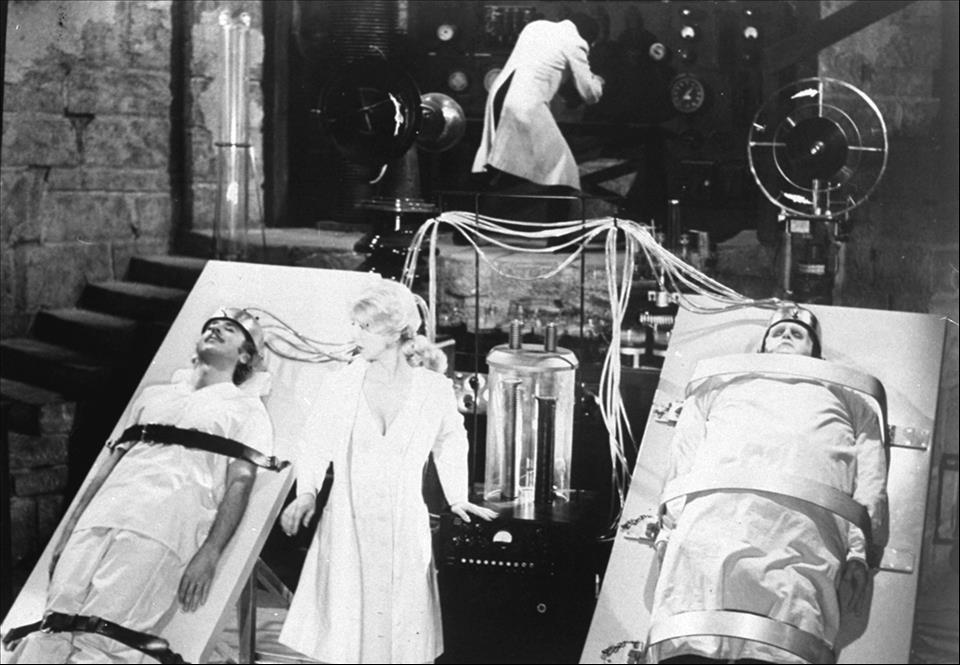
The Sharp, Smart Humour Of Mel Brooks' Young Frankenstein And Gene Wilder's Genius Performance Still Stands Up After 50 Years
In addition to three different screens, there was McClure's Restaurant where on each table sat a black telephone with a direct line through to some“off-screen” waiter who took your order. The height of sophistication.
I would also pick up the latest copy of the Hoyts movie magazine filled with full page movie posters. A whole wall of my bedroom was devoted to these miniature movie-daybills, one of which featured an image of the Frankenstein castle flanked by Gene Wilder, his wild-eyed, wild-haired face all hysterical madness and Peter Boyle, his comic-horror, reanimated-corpse-face sublimely tipping his top hat.
“A Mel Brooks Film” it said and beneath that, in large letters seemingly carved from stone, the words Young Frankenstein.
The genius of Gene WilderA new Mel Brooks film was an exciting prospect. My parents took me to Blazing Saddles at the Dendy Brighton where an organist played a Wurlitzer rising from deep in the cinema's bowels.
Back then, that Western parody was the funniest film I'd ever seen. So, with much anticipation, my friends and I rushed to Cinema Centre to see Young Frankenstein. It did not disappoint. Even as the credits rolled, we were quoting funny lines and describing funny scenes to each other, like we hadn't all just seen it. That was 50 years ago.
Revisiting old favourite films can be fraught. What the teenager found funny in the 70s mightn't hold true for his grown-up self. Contemporary sensibilities differ quite markedly over time.
Blazing Saddles is a good example. I tried rewatching it a while ago and had to turn off after 20 minutes. There was still plenty to make me laugh but its casual racism and sexism undercut that. So, why isn't that the case with Young Fronk-en-shteen (as Frederick would say)?
For me, the answer is Gene Wilder.
Wilder worked with Brooks on The Producers (1967) and again on Blazing Saddles (1974), during which he started writing Young Frankenstein. Wilder wasn't adapting Mary Shelley's novel. This was an homage to James Whale's cinema classics Frankenstein (1931) and Bride of Frankenstein (1935), retold through a parodic but ultimately respectful lens.
Wilder was new to screenwriting but Brooks already had a best original screenplay Oscar for The Producers, so Wilder asked Brooks to co-write and direct. Wilder's one condition was that Brooks wouldn't act in the film, ostensibly because he wanted him to focus on directing. I can't help think Brooks' broad, vulgar comedic acting would have changed the dynamic undercutting the genius of Wilder's seemingly out-of-control performance that, in reality, is anything but.
Where I think Wilder's sensibility differs from Brooks is exemplified by the Puttin' on the Ritz song and dance scene. Brooks wanted to cut it for continuity reasons. Wilder insisted it stay. He knew what he was talking about. It's arguably the funniest scene in the film.
A beautifully made filmOf course, some of it doesn't stand up – breast and penis jokes, salacious double entendres – but they are far outweighed by its sharper, smarter humour delivered by a cast of comic actors at the top of their game: Marty Feldman, Teri Garr, Peter Boyle, Cloris Leachman, Madeline Kahn, Kenneth Mars and a surprising first crack at comedy by Wilder's tennis partner, Gene Hackman.
Plus, it's beautifully made.
Wilder's desire to honour Whale's films whilst poking fun at them is borne out by Brooks' direction. It's as though the ghost of Whale was behind the camera. The recreation of 1930s style horror filmmaking is elevated by the shadows and light of Gerald Hirschfeld's glorious black and white cinematography.
The film was originally to be produced by Columbia Pictures who called off the deal when Brooks mentioned it would be shot in black and white. Columbia suggested using colour but Brooks and Wilder stuck to their guns. Twentieth Century Fox quickly capitalised on Columbia's short sightedness.
Then there is William Tuttle's inventive make up (that zipper on the side of the monster's skull was a workaround to avoid copyright on the classic bolts through the neck) and the use of the original Frankenstein laboratory equipment provided by Kenneth Strickfaden (who held onto it after creating it for the 1931 film).
Of course, Brooks and Wilder weren't the first to parody Frankenstein. First there was Abbott and Costello Meet Frankenstein (1948), but that and many other parody films like Airplane! (1980), The Naked Gun (1988) and Scary Movie (2000) are more about the gags than well-crafted narrative and character. That's where Young Frankenstein excels, even if some gags are dated.
Brooks and Wilder were nominated for the best adapted screenplay Oscar but lost out to Godfather II. Nevertheless, it deserves its 50th birthday resurgence. Time Magazine counts it among its top 100 films in its list of the ten best films from each of the past ten decades – the only Brooks' film to make the list!
But the proof of the pudding is in the rewatching. I did just that the other night, this time with my 19-year-old son. And just as it was 50 years ago, Young Frankenstein did not disappoint.

Legal Disclaimer:
MENAFN provides the
information “as is” without warranty of any kind. We do not accept
any responsibility or liability for the accuracy, content, images,
videos, licenses, completeness, legality, or reliability of the information
contained in this article. If you have any complaints or copyright
issues related to this article, kindly contact the provider above.

















Comments
No comment